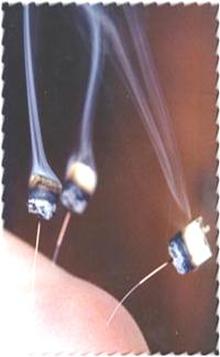
The Smell of Moxa in the Mornings
The first thing you may notice when entering the clinic is the smell (and sometimes sight) of smoke wafting through the air. This is not from our practitioners having a quiet cigar between patients, or anything else suspicious for that matter. This is the smell of Moxa, real name Artemesia Vulgaris, also known as Chinese mugwort, and has been an integral part of acupuncture from the start.
Acupuncture in chinese is Zhen Jiu ( 针 灸 ) - made up of the characters for needle 针 and cauterise 灸.. The word Moxa comes from the Japanese Mo Ku Sa - burning herb. Artemesia Vulgaris is known as Ai Ye in Chinese, and is used internally in herbal medicine as an ingredient mostly in gynaecological formulas.
Moxa is often burned as a part of acupuncture treatment to provide thermal stimulation, ie. heat. It may be used on its own as a stick to warm points on the skin, or used on the needles themselves to provide a penetrating heat which stimulates circulation, relaxes the muscles, and strengthens and warms the Qi. It's application varies from the treatment of arthritic joints and muscle pain, to diarrohea or hypothyroidism. Whether it is applied or not depends entirely on the diagnosis.
Historians believe that moxibustion actually pre-dates the use of acupuncture by hundreds of years and that acupuncture points were initially stimulated by small cones of the herb smouldering directly on the skin (don't worry - not a technique we employ in this clinic!).
More recent research has looked for any therapeutic effects of moxa in particular, but it seems that heat is the most important factor. The dried Artemisia just happens to burn consistently and cleanly enough that it is still the best way to deliver a measured amount of heat deep into a muscle, or to stimulate the Yang at an acupuncture point.
Back to articles
The first thing you may notice when entering the clinic is the smell (and sometimes sight) of smoke wafting through the air. This is not from our practitioners having a quiet cigar between patients, or anything else suspicious for that matter. This is the smell of Moxa, real name Artemesia Vulgaris, also known as Chinese mugwort, and has been an integral part of acupuncture from the start.
Acupuncture in chinese is Zhen Jiu ( 针 灸 ) - made up of the characters for needle 针 and cauterise 灸.. The word Moxa comes from the Japanese Mo Ku Sa - burning herb. Artemesia Vulgaris is known as Ai Ye in Chinese, and is used internally in herbal medicine as an ingredient mostly in gynaecological formulas.
Moxa is often burned as a part of acupuncture treatment to provide thermal stimulation, ie. heat. It may be used on its own as a stick to warm points on the skin, or used on the needles themselves to provide a penetrating heat which stimulates circulation, relaxes the muscles, and strengthens and warms the Qi. It's application varies from the treatment of arthritic joints and muscle pain, to diarrohea or hypothyroidism. Whether it is applied or not depends entirely on the diagnosis.
Historians believe that moxibustion actually pre-dates the use of acupuncture by hundreds of years and that acupuncture points were initially stimulated by small cones of the herb smouldering directly on the skin (don't worry - not a technique we employ in this clinic!).
More recent research has looked for any therapeutic effects of moxa in particular, but it seems that heat is the most important factor. The dried Artemisia just happens to burn consistently and cleanly enough that it is still the best way to deliver a measured amount of heat deep into a muscle, or to stimulate the Yang at an acupuncture point.
Back to articles